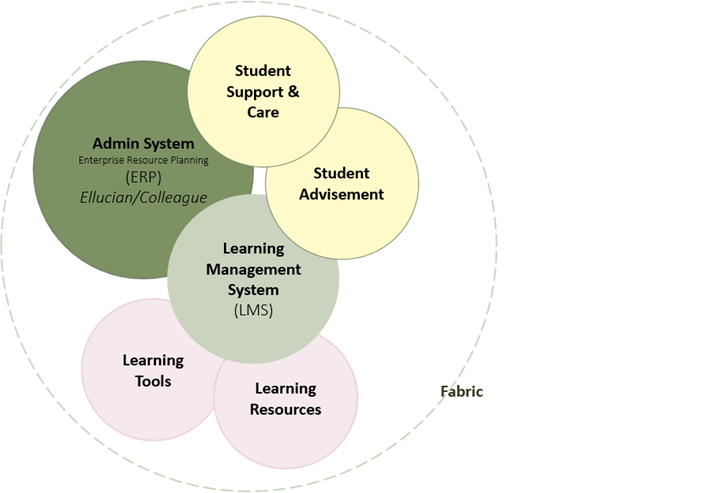Searching for "learning management"
http://www.edtec700de3.sdsu.edtechsource.com/content/joomlalms-vs-desire2learn-lee
http://richardcraigsnow.blogspot.com/2012/03/d2l-content-manager-improvements-i.html
http://scc-lmseval.blogspot.com/2008/02/desire2learn-is-lms-selection.html
https://www.edweek.org/leadership/remote-learning-will-keep-a-strong-foothold-even-after-the-pandemic-survey-finds/2020/12
Remote Learning Will Keep a Strong Foothold Even After the Pandemic, Survey Finds
The survey, conducted between Sept. 15 and Nov. 11, included seven questions that covered areas such as staffing challenges, professional development, and approaches to the 2020-21 school year.
The survey was sent to leaders in 317 regular public-school districts and charter management organizations, who are part of RAND’s district panel. The response rate was 84 percent.
Twenty percent of district and charter management organizations said in a new survey that they had started or were planning a virtual school or fully remote option this academic year and expected those options would remain after the pandemic. Another 10 percent said the same about hybrid or blended learning, while 7 percent said some lesser version of remote learning will continue when the pandemic is in the rearview mirror.
++++++++++++
more on the iGeneration Generation Z, Generation Y Generation Alpha in this IMS blog
https://blog.stcloudstate.edu/ims?s=generation
EDUCAUSE Academic Communities: Teaching and Learning + Student Success
https://events.educause.edu/webinar/2020/educause-academic-communities-teaching-and-learning-student-success
Tuesday, February 25, 2020, at 12:00 pm,
Miller Center, MC 205, the SCSU Professional Development Room
(how to get there? https://youtu.be/jjpLR3FnBLI )
You will receive an email from Canvas Catalog when you have been granted access to the event website. This site includes live event login details, program and speaker information, and technical requirements.
+++++++++++
My notes from the Adobe Connect webinar
Malcolm Brown (MB) and Kathe Pelletier (KP)
John Martin, UW-Madison: Interesting that “Student Success” = retention. I feel retention = org success.
Cindy Auclair: Cindy Auclair – ASU – Retention is important that goes hand in hand with well-being.
Kathy Fernandes, CSU Chico: Not sure how one would measure Becoming a Citizen? We do have public Debates, Town Hall, etc. to engage with community.
Lisa Durff: I thought of digital citizenship

Jim J – MiraCosta: “as a part of teaching and learning” is a real gray area –
Jim J – MiraCosta: We may measure all of these, but there is very little formality around “teaching and learning”
Lisa Durff: very few measure instructor satisfaction

student success after 2017 shifts from SS and technology to SS and other issues
digital transformation
why tech adoption doesn’t equal digital transformation. article from Forbes. MB: it is not for sale, cannot buy. not a product, but deep and coordinated shifts: culture, workforce, technology.
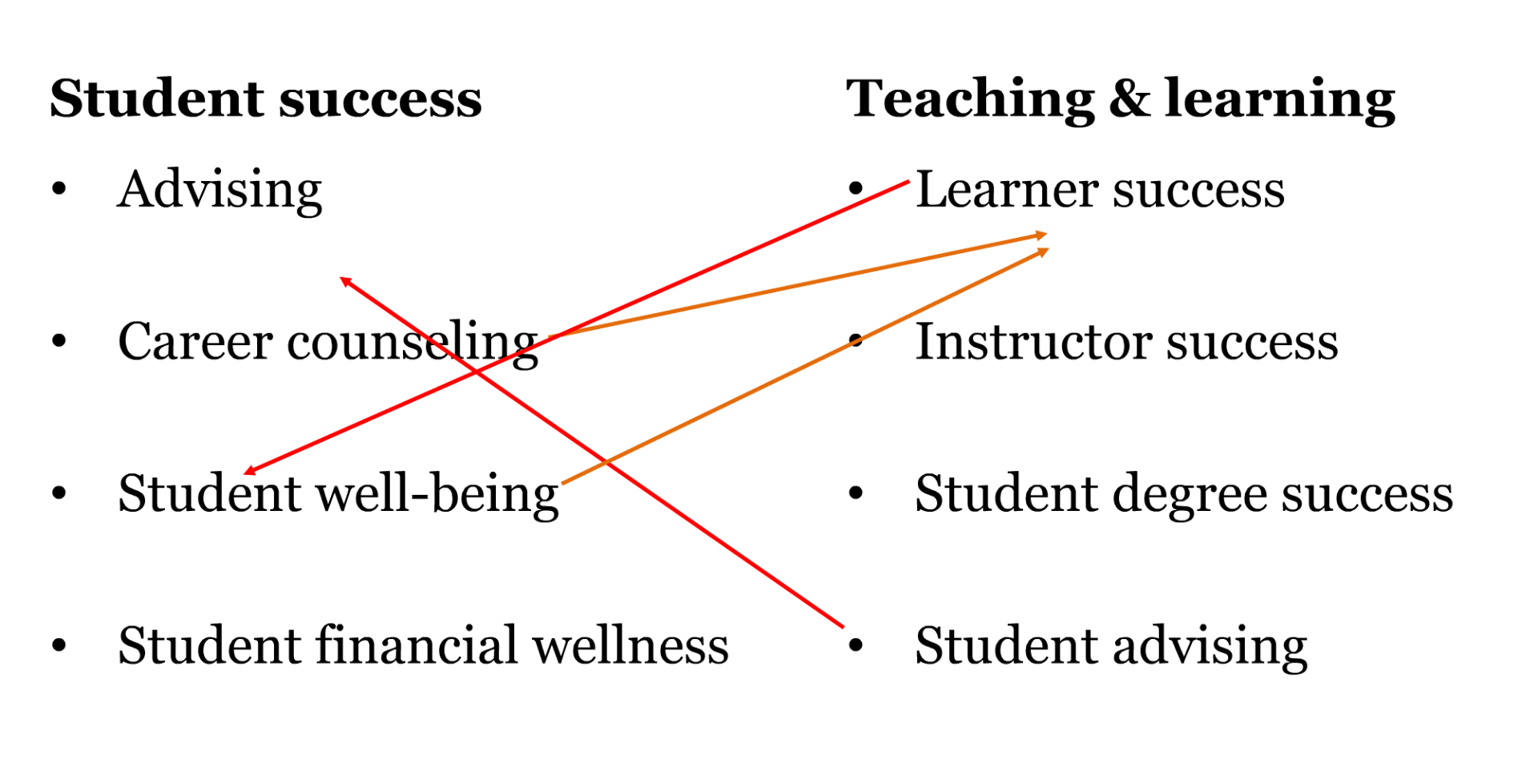
ask for EDUCAUSE Academic Communities PDF document
Malcolm Brown: 2019 Horizon Report https://library.educause.edu/resources/2019/4/2019-horizon-report
Malcolm Brown: Transforming Higher Ed blog https://er.educause.edu/columns/transforming-higher-ed
Malcolm Brown: EDUCAUSE Student Success https://library.educause.edu/topics/information-technology-management-and-leadership/student-success
https://www.educause.edu/research-and-publications/research/core-data-service
+++++++++++
more on Educause in this IMS blog
https://blog.stcloudstate.edu/ims?s=educause
Online Learning’s ‘Greatest Hits’
Robert Ubell (Columnist) Feb 20, 2019
https://www.edsurge.com/news/2019-02-20-online-learning-s-greatest-hits
dean of web-based distance learning
Learning Management Systems
Neck and neck for the top spot in the LMS academic vendor race are Blackboard—the early entry and once-dominant player—and coming-up quickly from behind, the relatively new contender, Canvas, each serving about 6.5 million students . The LMS market today is valued at $9.2 billion.
Digital Authoring Systems
Faced with increasingly complex communication technologies—voice, video, multimedia, animation—university faculty, expert in their own disciplines, find themselves technically perplexed, largely unprepared to build digital courses.
instructional designers, long employed by industry, joined online academic teams, working closely with faculty to upload and integrate interactive and engaging content.
nstructional designers, as part of their skillset, turned to digital authoring systems, software introduced to stimulate engagement, encouraging virtual students to interface actively with digital materials, often by tapping at a keyboard or touching the screen as in a video game. Most authoring software also integrates assessment tools, testing learning outcomes.
With authoring software, instructional designers can steer online students through a mixtape of digital content—videos, graphs, weblinks, PDFs, drag-and-drop activities, PowerPoint slides, quizzes, survey tools and so on. Some of the systems also offer video editing, recording and screen downloading options
Adaptive Learning
As with a pinwheel set in motion, insights from many disciplines—artificial intelligence, cognitive science, linguistics, educational psychology and data analytics—have come together to form a relatively new field known as learning science, propelling advances in a new personalized practice—adaptive learning.
MOOCs
Of the top providers, Coursera, the Wall Street-financed company that grew out of the Stanford breakthrough, is the champion with 37 million learners, followed by edX, an MIT-Harvard joint venture, with 18 million. Launched in 2013, XuetangX, the Chinese platform in third place, claims 18 million.
Former Yale President Rick Levin, who served as Coursera’s CEO for a few years, speaking by phone last week, was optimistic about the role MOOCs will play in the digital economy. “The biggest surprise,” Levin argued, “is how strongly MOOCs have been accepted in the corporate world to up-skill employees, especially as the workforce is being transformed by job displacement. It’s the right time for MOOCs to play a major role.”
In virtual education, pedagogy, not technology, drives the metamorphosis from absence to presence, illusion into reality. Skilled online instruction that introduces peer-to-peer learning, virtual teamwork and other pedagogical innovations stimulate active learning. Online learning is not just another edtech product, but an innovative teaching practice. It’s a mistake to think of digital education merely as a device you switch on and off like a garage door.
++++++++++
more on online learning in this IMS blog
https://blog.stcloudstate.edu/ims?s=online+learning
Gunawan, F. (2018). GAMIFICATION ANALYSIS AND IMPLEMENTATION IN ONLINE LEARNING. ICIC Express Letters, 12(12), 1195–1204.
Khan [14] has introduced the eight-dimensional elearning framework, a detailed self assessment instrument for institutions to evaluate the readiness and the opportunity of their e-learning classes to grow.
institutional, management, technological, pedagogical, ethical, interface design, resource support, and evaluation. Institutional refers to the administrative and academic part of the system. Management refers to the quality control, budget, and scheduling. Technological refers to the infrastructure, hardware, and software. Pedagogical refers to analysis, organization and learning strategies. Ethical refers to ethical, legal, and social and political influences. Interface design refers to the user interface, accessibility, and design content. Resource support refers to career services, journals, and online forums. Finally, the evaluation refers to the assessment of learners and educators.
gamification – definition
Modern gamification term was first introduced by
Nick Pelling in 2002 [15]. Gamification is a concept that implements the game components
into the non-game contents such as education, marketing, administration, or even software
engineering [16]. These components include points, badges, leaderboards, and quests.
Each of them serves the purpose to increase the level of user engagement in the learning
process.
three components of engagement: cognitive, behavioral, and emotional [19].
https://www.edsurge.com/news/2017-04-19-online-courses-shouldn-t-use-remote-proctoring-tools-here-s-why
when the option between taking a course online or in-person is provided, studies show students are more likely to stay in college.
Since the early days of online instruction, the response of many new instructors has been to figure out how to transfer elements of their face-to-face class into the online format. In response, education technology companies have been quick to create products that attempt to replicate in-person teaching. Some examples include learning management systems, lecture capture tools, and early online meeting systems.
online proctoring systems, such as ProctorU or Proctorio, replicate a practice that isn’t effective in-person. Exams are only good for a few things: managing faculty workload and assessing low level skill and content knowledge. What they aren’t good at is demonstrating student learning or mastery of a topic. As authors Rena Palloff and Keith Pratt discuss in their book “Assessing the Online Learner: Resources and Strategies for Faculty,” online exams typically measure skills that require memorization of facts, whereas learning objectives are often written around one’s ability to create, evaluate and analyze course material.
Authentic assessments, rather than multiple choice or other online exams, is one alternative that could be explored. For example, in a chemistry course, students could make a video themselves doing a set problems and explain the process. This would allow instructors to better understand students’ thinking and identify areas that they are struggling in. Another example could be in a psychology course, where students could curate and evaluate a set of resources on a given topic to demonstrate their ability to find, and critically analyze online information. (see Bryan Alexander‘s take on video assignments here: https://blog.stcloudstate.edu/ims?s=bryan+alexander+video+assignments
+++++++++++
more on online learning in this IMS blog
https://blog.stcloudstate.edu/ims?s=online+learning
more on proctoring in this IMS blog
https://blog.stcloudstate.edu/ims?s=proctor
 Watch Out, Corporate Learning: Here Comes Disruption
Watch Out, Corporate Learning: Here Comes Disruption
Josh Bersin March 28, 2017 https://www.forbes.com/sites/joshbersin/2017/03/28/watch-out-corporate-learning-here-comes-disruption/#5bd1a35edc59
The corporate training market, which is over $130 billion in size, is about to be disrupted. Companies are starting to move away from their Learning Management Systems (LMS), buy all sorts of new tools for digital learning, and rebuild a whole new infrastructure to help employees learn. And the impact of GSuite, Microsoft Teams, Slack, and Workplace by Facebook could be enormous.
 The corporate L&D market has been through wrenching change over the last decade. In only 15 years we’ve come from long, page-turning courses to a wide variety of videos, small micro-learning experiences, mobile apps, and intelligent, adaptive learning platforms.
The corporate L&D market has been through wrenching change over the last decade. In only 15 years we’ve come from long, page-turning courses to a wide variety of videos, small micro-learning experiences, mobile apps, and intelligent, adaptive learning platforms.
A new marketplace of tools vendors has emerged, most less than five years old, each trying to stake out a new place in the landscape. These includes tools for external content curation, tools to build MOOCs internally, tools to deliver adaptive, micro-learning content, and intelligent tools to help recommend content, assess learning, practice and identify skills gaps.
We know employees badly need these kinds of tools. Employees are pretty overwhelmed at work ,and typically only have 20 minutes a week to set aside for learning. So rather than produce two to three hour “courses” that require page-turning and slow video or animation, we need to offer “learning on-demand” and recommended content just as needed.
These changes will disrupt and change the $4 billion-plus for corporate learning management systems (LMS). Companies like IBM, Sears, and Visa are starting to turn off their old systems and build a new generation of learning infrastructure that looks more like a “learning network” and less like a single integrated platform.
https://blog.stcloudstate.edu/ims/2017/03/28/digital-learning/
+++++++++++++
more on digital learning in this IMS blog
https://blog.stcloudstate.edu/ims?s=digital+learning
How Game-Based Learning Empowers Students for the Future
https://www.edsurge.com/news/2019-01-22-its-2019-so-why-do-21st-century-skills-still-matter
educators’ guide to game-based learning, packed with resources for gaming gurus and greenhorns alike.
How are schools and districts preparing students for future opportunities? What is the impact of game-based learning?
It’s 2019. So Why Do 21st-Century Skills Still Matter?
21st-century trends such as makerspaces, flipped learning, genius hour, gamification, and more.
EdLeader21, a national network of Battelle for Kids.has developed a toolkit to guide districts and independent schools in developing their own “portrait of a graduate” as a visioning exercise. In some communities, global citizenship rises to the top of the wish list of desired outcomes. Others emphasize entrepreneurship, civic engagement, or traits like persistence or self-management.
ISTE Standards for Students highlight digital citizenship and computational thinking as key skills that will enable students to thrive as empowered learners. The U.S. Department of Education describes a globally competent student as one who can investigate the world, weigh perspectives, communicate effectively with diverse audiences, and take action.
Frameworks provide mental models, but “don’t usually help educators know what to do differently,” argues technology leadership expert Scott McLeod in his latest book, Harnessing Technology for Deeper Learning. He and co-author Julie Graber outline deliberate shifts that help teachers redesign traditional lessons to emphasize goals such as critical thinking, authenticity, and conceptual understanding.
1. Wondering how to teach and assess 21st-century competencies? The Buck Institute for Education offers a wide range of resources, including the book, PBL for 21st Century Success: Teaching Critical Thinking, Collaboration, Communication, and Creativity (Boss, 2013), and downloadable rubrics for each of the 4Cs.
2. For more strategies about harnessing technology for deeper learning,listen to the EdSurge podcast featuring edtech expert and author Scott McLeod.
3. Eager to see 21st-century learning in action? Getting Smart offers suggestions for using school visits as a springboard for professional learning, including a list of recommended sites. Bob Pearlman, a leader in 21st century learning, offers more recommendations.
++++++++++++++
more on game- based learning in this IMS blog
https://blog.stcloudstate.edu/ims?s=game+based
6 ways to use students’ smartphones for learning
By Kelsey Ehnle 12/26/2018 BYOD Mobile learning Tools
Smartphones also provide an easy way for teachers to “inspire students to positively contribute to and responsibly participate in the digital world,” as espoused by the
ISTE Standards for Educators.
research shows that when students are engaged in their learning — and they’re almost always engaged with their phones when given a choice — they are less likely to succumb to distractions.
1. Create short videos.
Videos can express any type of learning in any style, from music videos to interviews, book trailers, historical re-enactments, tutorials and stop animations.
Flipgrid is the one of the best educational video-creation sites
2. Access an online dictionary and thesaurus.
Find synonyms in many languages at Open Thesaurus!
Linguee.
PONS or LEO. Question about a verb conjugation? Go to LEO or Canoo (for German)
3. Collaborate and share with Padlet and Twitter.
4. Scan QR codes.
5. Listen to podcasts and read the news.
6. Compete against classmates!
Quizlet and Kahoot, Gimkit
https://blog.stcloudstate.edu/ims?s=kahoot
6. Use the apps, obviously.
++++++++++++++++
Gartner predicts that nearly 38 percent of companies will stop providing devices to workers by 2017 — but 20 percent of those BYOD programs will fail because of overly restrictive mobile device management measures. So how can IT pros devise a BYOD strategy that stays afloat? Here are six guidelines to accommodate legitimate IT concerns without sinking a policy’s odds of success:
Look to Existing Policies
Before creating a BYOD policy, take a look at existing HR and legal procedures. Many email, VPN, and remote access security policies can be applied to mobile devices, as well.
Provide Training and Education
Employees are using personal devices at work, whether the company realizes it or not. But that doesn’t mean they are using them correctly. Employees often use file-sharing and other tools of their choosing without IT’s knowledge, which could put sensitive corporate data at risk. Use a BYOD policy to trainemployees how to correctly use their applications
Specify Devices
BYOD isn’t limited to smartphones. According to Gartner, a “new norm” is emerging in which employees manage up to four or five devices at work.
Enforce Passwords and Encryption
passwords aren’t foolprool. Data encryption is an additional security measure
A smart BYOD policy doesn’t mean IT is off the hook. Rather, successful policies rely on IT and employees sharing security obligations.
Set Ownership Expectations
Employees often fail to realize that all data on their devices is discoverable, regardless of whether the device is personal or company-owned. The question of who owns what is still a legal gray area, though companies increasingly take the liberty to remote wipe employees’ personal devices once they leave their job. Avoid the guessing game with a clear exit strategy.
+++++++++++++++
more on BYOD in this IMS blog
https://blog.stcloudstate.edu/ims?s=byod
https://blog.stcloudstate.edu/ims?s=mobile+learning
Key Issues in Teaching and Learning
https://www.educause.edu/eli/initiatives/key-issues-in-teaching-and-learning
A roster of results since 2011 is here.
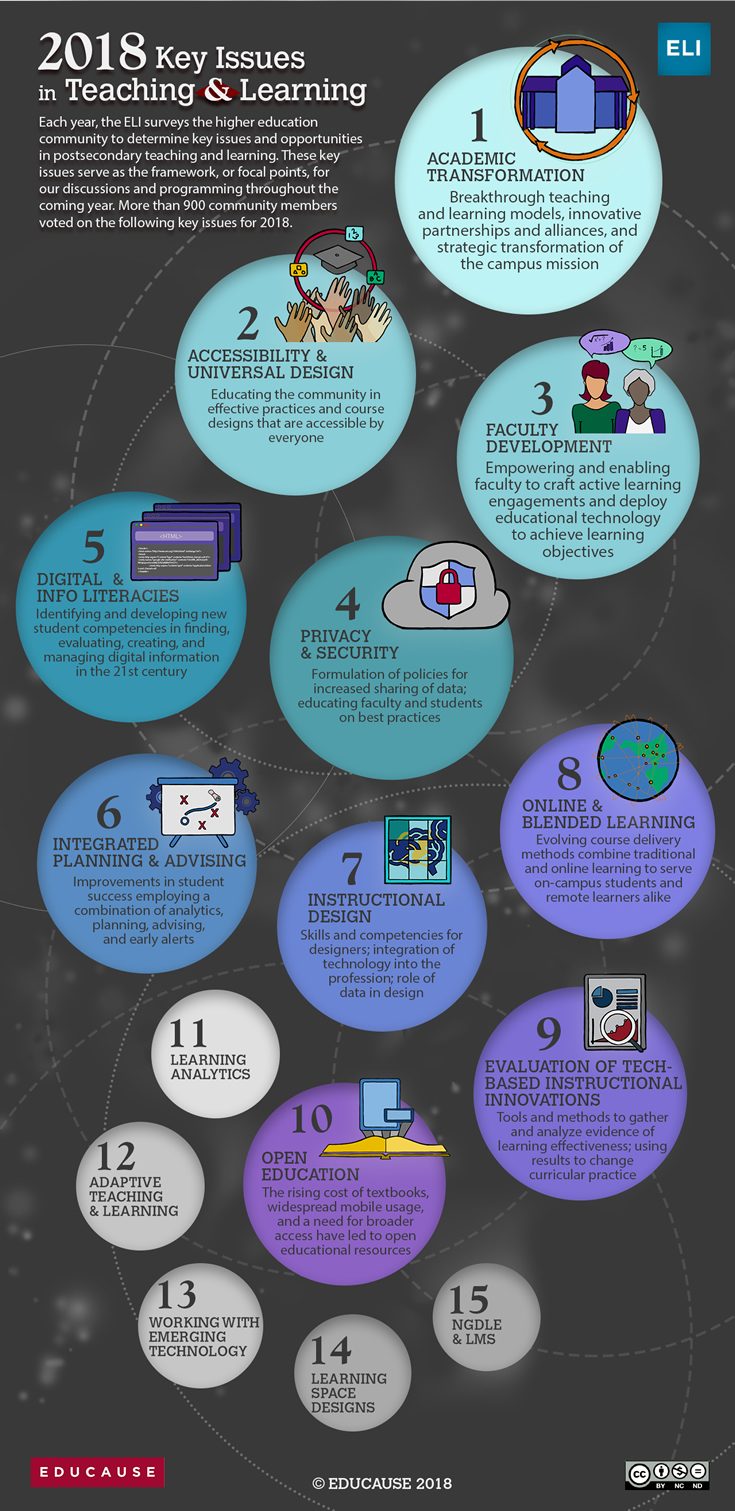
1. Academic Transformation
2. Accessibility and UDL
3. Faculty Development
4. Privacy and Security
5. Digital and Information Literacies
https://cdn.nmc.org/media/2017-nmc-strategic-brief-digital-literacy-in-higher-education-II.pdf
Three Models of Digital Literacy: Universal, Creative, Literacy Across Disciplines
United States digital literacy frameworks tend to focus on educational policy details and personal empowerment, the latter encouraging learners to become more effective students, better creators, smarter information consumers, and more influential members of their community.
National policies are vitally important in European digital literacy work, unsurprising for a continent well populated with nation-states and struggling to redefine itself, while still trying to grow economies in the wake of the 2008 financial crisis and subsequent financial pressures
African digital literacy is more business-oriented.
Middle Eastern nations offer yet another variation, with a strong focus on media literacy. As with other regions, this can be a response to countries with strong state influence or control over local media. It can also represent a drive to produce more locally-sourced content, as opposed to consuming material from abroad, which may elicit criticism of neocolonialism or religious challenges.
p. 14 Digital literacy for Humanities: What does it mean to be digitally literate in history, literature, or philosophy? Creativity in these disciplines often involves textuality, given the large role writing plays in them, as, for example, in the Folger Shakespeare Library’s instructor’s guide. In the digital realm, this can include web-based writing through social media, along with the creation of multimedia projects through posters, presentations, and video. Information literacy remains a key part of digital literacy in the humanities. The digital humanities movement has not seen much connection with digital literacy, unfortunately, but their alignment seems likely, given the turn toward using digital technologies to explore humanities questions. That development could then foster a spread of other technologies and approaches to the rest of the humanities, including mapping, data visualization, text mining, web-based digital archives, and “distant reading” (working with very large bodies of texts). The digital humanities’ emphasis on making projects may also increase
Digital Literacy for Business: Digital literacy in this world is focused on manipulation of data, from spreadsheets to more advanced modeling software, leading up to degrees in management information systems. Management classes unsurprisingly focus on how to organize people working on and with digital tools.
Digital Literacy for Computer Science: Naturally, coding appears as a central competency within this discipline. Other aspects of the digital world feature prominently, including hardware and network architecture. Some courses housed within the computer science discipline offer a deeper examination of the impact of computing on society and politics, along with how to use digital tools. Media production plays a minor role here, beyond publications (posters, videos), as many institutions assign multimedia to other departments. Looking forward to a future when automation has become both more widespread and powerful, developing artificial intelligence projects will potentially play a role in computer science literacy.
6. Integrated Planning and Advising Systems for Student Success (iPASS)
7. Instructional Design
8. Online and Blended Learning
In traditional instruction, students’ first contact with new ideas happens in class, usually through direct instruction from the professor; after exposure to the basics, students are turned out of the classroom to tackle the most difficult tasks in learning — those that involve application, analysis, synthesis, and creativity — in their individual spaces. Flipped learning reverses this, by moving first contact with new concepts to the individual space and using the newly-expanded time in class for students to pursue difficult, higher-level tasks together, with the instructor as a guide.
Let’s take a look at some of the myths about flipped learning and try to find the facts.
Myth: Flipped learning is predicated on recording videos for students to watch before class.
Fact: Flipped learning does not require video. Although many real-life implementations of flipped learning use video, there’s nothing that says video must be used. In fact, one of the earliest instances of flipped learning — Eric Mazur’s peer instruction concept, used in Harvard physics classes — uses no video but rather an online text outfitted with social annotation software. And one of the most successful public instances of flipped learning, an edX course on numerical methods designed by Lorena Barba of George Washington University, uses precisely one video. Video is simply not necessary for flipped learning, and many alternatives to video can lead to effective flipped learning environments [http://rtalbert.org/flipped-learning-without-video/].
Myth: Flipped learning replaces face-to-face teaching.
Fact: Flipped learning optimizes face-to-face teaching. Flipped learning may (but does not always) replace lectures in class, but this is not to say that it replaces teaching. Teaching and “telling” are not the same thing.
Myth: Flipped learning has no evidence to back up its effectiveness.
Fact: Flipped learning research is growing at an exponential pace and has been since at least 2014. That research — 131 peer-reviewed articles in the first half of 2017 alone — includes results from primary, secondary, and postsecondary education in nearly every discipline, most showing significant improvements in student learning, motivation, and critical thinking skills.
Myth: Flipped learning is a fad.
Fact: Flipped learning has been with us in the form defined here for nearly 20 years.
Myth: People have been doing flipped learning for centuries.
Fact: Flipped learning is not just a rebranding of old techniques. The basic concept of students doing individually active work to encounter new ideas that are then built upon in class is almost as old as the university itself. So flipped learning is, in a real sense, a modern means of returning higher education to its roots. Even so, flipped learning is different from these time-honored techniques.
Myth: Students and professors prefer lecture over flipped learning.
Fact: Students and professors embrace flipped learning once they understand the benefits. It’s true that professors often enjoy their lectures, and students often enjoy being lectured to. But the question is not who “enjoys” what, but rather what helps students learn the best.They know what the research says about the effectiveness of active learning
Assertion: Flipped learning provides a platform for implementing active learning in a way that works powerfully for students.
9. Evaluating Technology-based Instructional Innovations

What is the total cost of my innovation, including both new spending and the use of existing resources?
What’s the unit I should measure that connects cost with a change in performance?
How might the expected change in student performance also support a more sustainable financial model?
The Exposure Approach: we don’t provide a way for participants to determine if they learned anything new or now have the confidence or competence to apply what they learned.
The Exemplar Approach: from ‘show and tell’ for adults to show, tell, do and learn.
The Tutorial Approach: Getting a group that can meet at the same time and place can be challenging. That is why many faculty report a preference for self-paced professional development.build in simple self-assessment checks. We can add prompts that invite people to engage in some sort of follow up activity with a colleague. We can also add an elective option for faculty in a tutorial to actually create or do something with what they learned and then submit it for direct or narrative feedback.
The Course Approach: a non-credit format, these have the benefits of a more structured and lengthy learning experience, even if they are just three to five-week short courses that meet online or in-person once every week or two.involve badges, portfolios, peer assessment, self-assessment, or one-on-one feedback from a facilitator
The Academy Approach: like the course approach, is one that tends to be a deeper and more extended experience. People might gather in a cohort over a year or longer.Assessment through coaching and mentoring, the use of portfolios, peer feedback and much more can be easily incorporated to add a rich assessment element to such longer-term professional development programs.
The Mentoring Approach: The mentors often don’t set specific learning goals with the mentee. Instead, it is often a set of structured meetings, but also someone to whom mentees can turn with questions and tips along the way.
The Coaching Approach: A mentor tends to be a broader type of relationship with a person.A coaching relationship tends to be more focused upon specific goals, tasks or outcomes.
The Peer Approach:This can be done on a 1:1 basis or in small groups, where those who are teaching the same courses are able to compare notes on curricula and teaching models. They might give each other feedback on how to teach certain concepts, how to write syllabi, how to handle certain teaching and learning challenges, and much more. Faculty might sit in on each other’s courses, observe, and give feedback afterward.
The Self-Directed Approach:a self-assessment strategy such as setting goals and creating simple checklists and rubrics to monitor our progress. Or, we invite feedback from colleagues, often in a narrative and/or informal format. We might also create a portfolio of our work, or engage in some sort of learning journal that documents our thoughts, experiments, experiences, and learning along the way.
The Buffet Approach:
10. Open Education

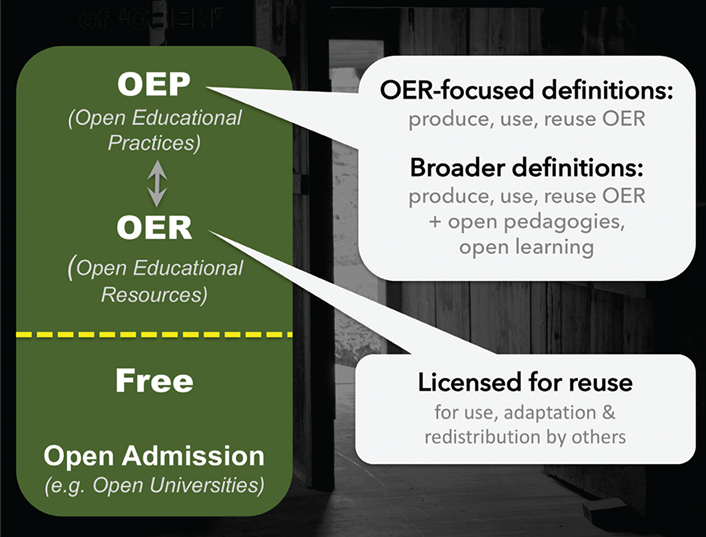
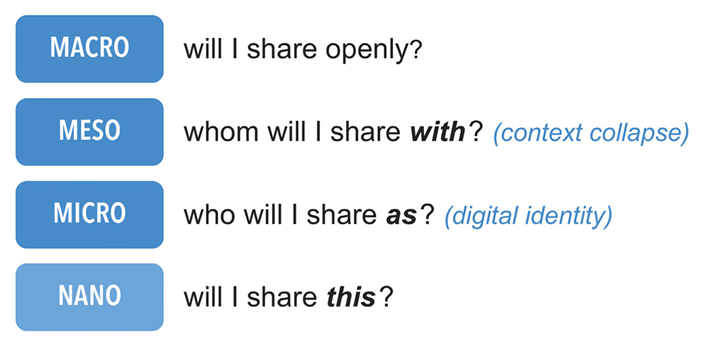
11. Learning Analytics
12. Adaptive Teaching and Learning
13. Working with Emerging Technology
In 2014, administrators at Central Piedmont Community College (CPCC) in Charlotte, North Carolina, began talks with members of the North Carolina State Board of Community Colleges and North Carolina Community College System (NCCCS) leadership about starting a CBE program.
Building on an existing project at CPCC for identifying the elements of a digital learning environment (DLE), which was itself influenced by the EDUCAUSE publication The Next Generation Digital Learning Environment: A Report on Research,1 the committee reached consensus on a DLE concept and a shared lexicon: the “Digital Learning Environment Operational Definitions,
